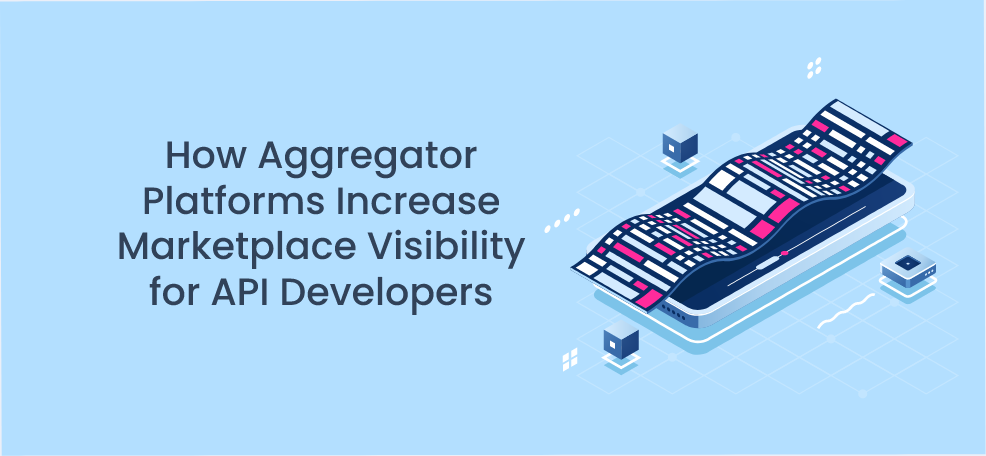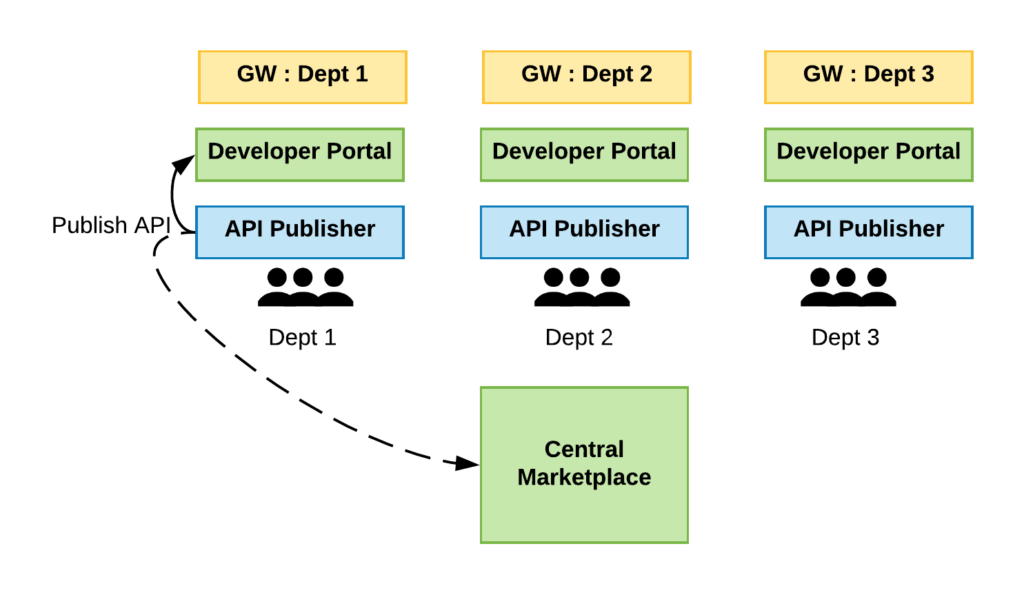As an API developer, you may build the most amazing API in the world, but getting the word out about it can feel next to impossible.
Getting your website optimized so that it shows up on the first or second page of search results is a huge challenge. That is where API marketplaces, including aggregator platforms, can be extremely helpful.
They bring potential customers to the marketplace, which means you can spend more time focusing on building APIs.
An Overview of API Marketplaces
There are several types of API marketplaces out there. Like well-known online marketplaces like Amazon, you can list your APIs for sale on an API marketplace.

Customers search for what they are looking for, as they would with any other online marketplace. When they find the right product listed, they can purchase the API.
Also, like other marketplaces, API platforms have several components, including a developer portal and an API provider portal.
Developer Portals
The developer portal of an API marketplace enables developers to easily find and connect to APIs.
Developers are typically able to look through categories and collections and search for the precise type of API and functionality that they are looking for.
The marketplace will usually also allow consumers to see pricing information, endpoints, and other helpful information up front, to help them determine which API is best for their needs.
Provider Portals
The provider portal of an API marketplace enables API providers to publish APIs so that developers can find them.
API marketplaces also typically allow providers to monetize their APIs, often by creating a subscription plan or a variety of subscription plans.
API Marketplaces Have Numerous Benefits
There are many benefits of API marketplaces for API developers and providers.
Above all, an API marketplace makes it possible to publish an API without having to build payment systems, employ management processes, and use a complex infrastructure.
In turn, that can save developers and providers time and money.
How an Aggregator Marketplace Can Increase API Visibility
API marketplaces fall into five main categories: internal marketplaces, partner marketplaces, closed group marketplaces, shared revenue marketplaces, and aggregator marketplaces.
Once you have gone through the process of developing an API, it is crucial that you find the best type of marketplace to increase market visibility.
One of the best options is an aggregator marketplace.
How does an aggregator platform work?
Quite simply, an aggregator marketplace is a platform where you provide your APIs.
The APIs or parts of the APIs can be taken and made into products that are value bundles. Those bundles are then sold through the marketplace.
The components of a single product that is for sale can come from multiple parties. That means the revenue created by the sale of the product is shared, in a staggered way.
Basically, with an aggregator platform model, consumers of the hub pay for the API products that they consume from the hub while the owner of the hub retains some of that revenue and then distributes the rest to the providers who provided the building blocks for the products that were sold.
Why are aggregator platforms so good for increasing API marketplace visibility?
When you provide an API or an API component to an aggregator platform, you will have your own developer portal and gateway. And the aggregator marketplace will have its own publisher because the aggregation needs to happen on that platform.
An aggregator marketplace will consist of at least one hub. API providers will create their API products on the hub publisher via a valid definition.
From the hub publisher, the APIs or API components are published to the hub developer portal. That greatly increases marketplace visibility because the hub will have its own consumer bases that subscribe to and consume the API products. Also, the hub will have its own gateway.
The More Hubs You Use, the Wider an Audience You Can Reach
Multiple hubs can be utilized. For instance, one hub would provide some of its API products to a second hub. The second hub would have its own set of API providers as well as its own collection of API products for sale.
Therefore, the API products that are shared from the first hub to the second hub can gain revenue via both platforms.
Of course, the marketplace visibility of the API products becomes much higher when the products are available via more than one hub.
When API products are shared among multiple hubs, the marketplace visibility and level of sales will increase even more.
Other Types of API Marketplaces
When APIs are made available in a shared environment like an aggregator marketplace, in which API products and components are listed, it becomes much easier and quicker to sell your APIs.
The right API marketplace can create a more interesting space and a richer environment. It can also foster the growth of APIs across both external and internal ecosystems.
But aggregator marketplaces are not the only type of API marketplace.
As briefly mentioned earlier, API developers also have the opportunity to increase the marketplace visibility of their API products by using internal marketplaces, partner marketplaces, closed group marketplaces, or shared revenue marketplaces.
Internal Marketplaces
An internal marketplace is limited to just a single organization.
Different teams or departments that own and manage APIs can use a common platform for reuse within the organization. The consumers consist of both internal people and external partners.
Because internal marketplaces involve numerous API owners, there is autonomy in how an API is defined and managed. But an internal marketplace is still a common marketplace, which means there will be some form of overall quality control and governance when an API is published to the platform to ensure each API conforms to a base quality level.
With internal marketplaces, there is no revenue incentive for the different units. The main goal of an internal marketplace is reuse and collaboration.
Partner Marketplaces
A partner marketplace is basically an extension of an internal marketplace.
With partner marketplaces, different internal units still publish their APIs to the platform. But in addition, partner organizations are recognized as well. So, partners become a part of the overall ecosystem.
On partner marketplaces, the underlying API management platform will need to support the external identities of the partner organizations. That can be achieved either via federation or by incorporating the partner’s user store during the deployment.
Closed Group Marketplaces
Closed group marketplaces are not limited to a single organization, as with internal marketplaces.
A closed group marketplace is common to multiple organizations. Those organizations are linked with a common focus. That usually means the organizations belong to the same industry or theme of operation, or they are working towards a common goal.
Even though the success of closed group marketplaces is reliant on several organizations being involved, as you may have guessed from the name, not every organization is permitted to join a closed group marketplace.
Accepted organizations will need to fulfill criteria based on commonality parameters.
In the closed group marketplace model, each organization could have its own API management infrastructure, but they will share common elements, especially when they are published via a common developer portal.
Also, each organization participating in a closed group marketplace will have its own security components and gateway. And the underlying API management platform will need to be able to create unified APIs that are based on a standard specification.
The APIs will also need to be able to seamlessly integrate with external identity providers, and sometimes gateways as well.
Shared Revenue Marketplaces
Shared revenue marketplaces are API marketplaces that are open to anyone who wishes to host their API products on a known platform.
Unlike closed group marketplaces, shared revenue marketplaces have no restrictions for organizations to join, other than standard base validity checks.
So, almost any organization can start using shared revenue platforms and publishing their APIs to create greater marketplace visibility for their products.
As the name implies, a shared revenue marketplace involves sharing revenue with the other API providers. The APIs listed on the platform can be monetized either directly or indirectly.
Summing Up
While API marketplaces like aggregator platforms are similar in many ways to other online marketplaces, they mostly differ due to being API specific.
Developers, providers, and consumers can all value the API buying and selling experience better via an aggregator marketplace.
However, before you begin publishing APIs on aggregator platforms, it is important that you spend time learning about the specific features and the model of a platform to ensure it is the best option for you.
Aggregator platforms are often the best choice, and as we have seen, they benefit developers by creating greater marketplace visibility. But sometimes an internal marketplace, a partner marketplace, a closed group marketplace, or a shared revenue marketplace could be a better option.
Of course, you also can use a combination of platforms to create even greater marketplace visibility for your API products and increase sales.





